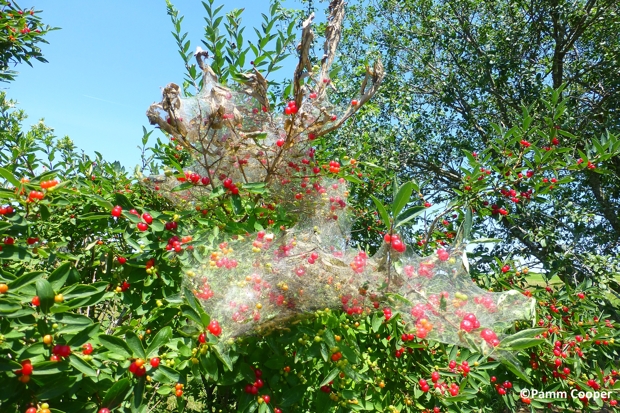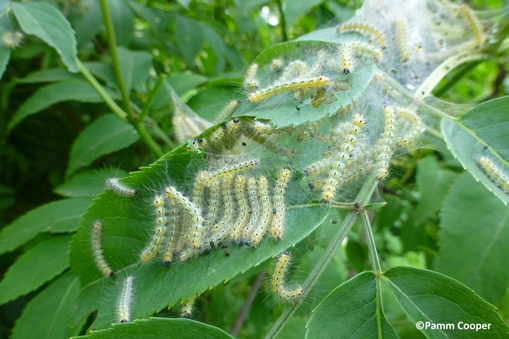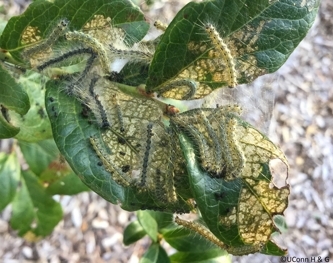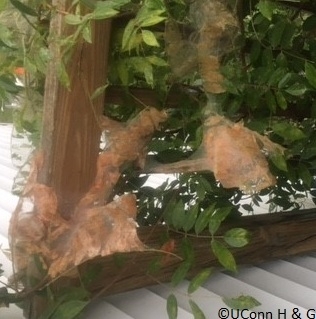Fall Webworm
Hyphantria cunea

The Fall webworm caterpillar, Hyphantria cunea, in the family Arctiidae, is a pest native to North America that can cause serious defoliation to deciduous trees and shrubs. It is often mistaken for the Gypsy moth caterpillar (which does not create webs) and the Eastern tent caterpillar (which does create tents). The eastern tent caterpillar nests are found in the crotch of branches in the spring while the fall webworm starts to create its silken tents over the ends of branches in beginning in late June through August, gradually extending down the branch as it encompasses the foliage that it is feeding upon. A single host plant may contain several tents containing larval communities. The defoliation is generally aesthetic and generally not injurious to overall health of the host plant. Occasionally multiple nests can cause serious damage.
Life Cycle
The fall webworm overwinters as cocooned pupa in the soil, in leaf debris, or in cracks or crevices. The brown pupal case is about 1/3” (10mm) long and may have bits of leaf litter woven into it. The white moth will begin to appear in June and some will continue to emerge in lesser numbers during the summer. The light yellow/green masses of several hundred eggs are laid on the undersides of leaves.
Larvae may hatch as soon as mid-June and will immediately begin to feed and create the silken tents that will surround them and the foliage. The tents will be home to many larvae and as they grow they will enlarge the tent to surround new foliage. They generally feed within its protection, only leaving to form a new tent or to seek a pupation site in or on the soil, leaf litter or protective cracks or crevices. The black-headed, hairy caterpillars leave the tents during their fifth instar to feed outside the nest. Single caterpillars in their final instar will leave the host plant and may be found almost anywhere as they search for a suitable pupation site. There is one generation per year in Connecticut that matures in about 6 weeks. There may sometimes be a second generation which will appear later in the summer.

Larvae yellow/green, caterpillars with white hairs coming out of black warts. Here in Connecticut, the caterpillars have black heads.

Black-headed fall webworm caterpillars on blueberry.
Hosts
Host plants of the fall webworm are mostly hardwood deciduous trees and shrubs including but not limited to American elm (Ulmus americana), Birch (Betula), Cherry (Prunus), Crabapple (Malus), Hickory (Carya), Lilac (Syringa), Maple (Acer), and Walnut (Juglans).
Control Measures

- Remove all tents and open to expose caterpillars to birds and other predators, or bag and trash them.
- Early scouting is the best defense.
- More than 50 species of parasitoid wasps and flies are natural predators of the fall webworm caterpillar.
- Bacillus thuringiensis var. Kurstaki (BtK) is a soil-borne bacteria that must be consumed by the larvae. It is the most effective within the first few weeks after hatching when the larvae are small and should be applied to the foliage adjacent to the web.
- Use a high-pressure spray on tents that are higher up.
- Spinosad is a bacterial insecticide that works both by contact and by ingestion, attacking the nervous system of the insect. Apply to the foliage. While wet, spinosad is toxic to bees and should not be applied to plants in flower.
Despite good cultural practices, pests and diseases at times may appear. Chemical control should be used only after all other methods have failed.
For pesticide information or other questions please call toll free: 877-486-6271.
UConn Home and Garden Education Center, 2019
Issued in furtherance of Cooperative Extension work, Acts of May 8 and June 30, 1914, in cooperation with the U.S. Department of Agriculture, the Dean of the College, Cooperative Extension System, University of Connecticut, Storrs. The Connecticut Cooperative Extension System is an equal opportunity employer and program provider. To file a complaint of discrimination, write USDA, Director, Office of Civil Rights, Room 326-W, Whitten Building, Stop Code 9410, 1400 Independence Avenue, SW, Washington, DC 20250-9410 or call (202) 720-5964.